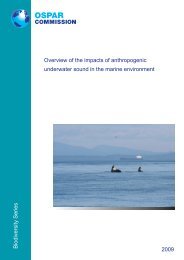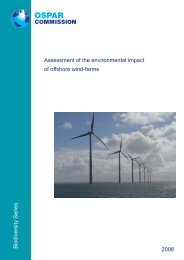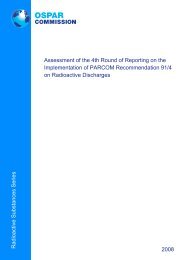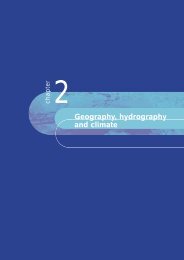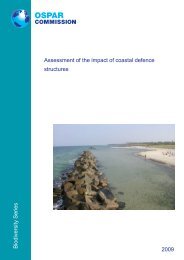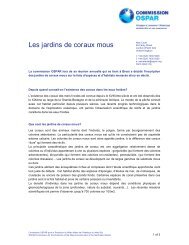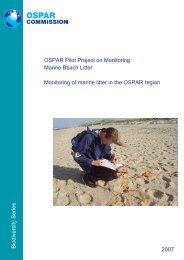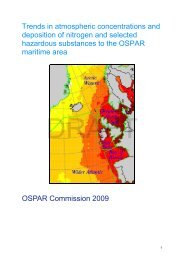Assessment of Modiolus modiolus beds in the OSPAR area Ivor ...
Assessment of Modiolus modiolus beds in the OSPAR area Ivor ...
Assessment of Modiolus modiolus beds in the OSPAR area Ivor ...
Create successful ePaper yourself
Turn your PDF publications into a flip-book with our unique Google optimized e-Paper software.
should occur is less practicable due to <strong>the</strong> complex <strong>of</strong> biological feedback loops <strong>in</strong>volved. Some <strong>Modiolus</strong><br />
<strong>beds</strong> have probably existed at or near <strong>the</strong> same locations for so long that <strong>the</strong>y may have orig<strong>in</strong>ally developed<br />
when environmental conditions were different from today and might be regarded as relicts. In situations<br />
where isostatic rebound has altered depths and local current flows <strong>beds</strong> may persist <strong>in</strong> sub-optimal<br />
conditions.<br />
3.3 Condition (current/trends/future prospects)<br />
The condition <strong>of</strong> <strong>Modiolus</strong> <strong>beds</strong> may be judged <strong>in</strong> several different ways:-<br />
• Spatial <strong>in</strong>tegrity, such as whe<strong>the</strong>r fish<strong>in</strong>g gear tracks cut across a bed.<br />
• Topographic <strong>in</strong>tegrity, such as <strong>the</strong> cont<strong>in</strong>ued presence <strong>of</strong> ridges, mounds and o<strong>the</strong>r biogenic relief.<br />
• Size distributions <strong>of</strong> <strong>the</strong> mussels and whe<strong>the</strong>r <strong>the</strong> populations are be<strong>in</strong>g adequately renewed by<br />
successful spat settlement and juvenile survival through <strong>the</strong> first years when <strong>the</strong>y are most<br />
vulnerable to predation.<br />
• Abundance, composition, condition and diversity <strong>of</strong> <strong>the</strong> associated biota. For physical disturbance<br />
impacts, changes <strong>in</strong> s<strong>of</strong>t epifauna are more likely. Some <strong>of</strong> <strong>the</strong> vagile epifauna, such as brittlestars<br />
(e.g. Ophiothrix fragilis) are known to fluctuate markedly <strong>in</strong> abundance, so caution is needed when<br />
<strong>in</strong>terpret<strong>in</strong>g change. Damage also leads to <strong>in</strong>creased abundance <strong>of</strong> scavengers, which are attracted to<br />
disturbed <strong>area</strong>s.<br />
Only a few <strong>beds</strong> are known have been surveyed over long enough time spans for evidence <strong>of</strong> change to be<br />
apparent. In <strong>the</strong> Irish Sea, south <strong>of</strong> <strong>the</strong> Isle <strong>of</strong> Man, an extensive bed was almost completely lost due to<br />
scallop dredg<strong>in</strong>g (Veale et al, 2000). For similar reasons, <strong>beds</strong> <strong>in</strong> Strangford Lough (Nor<strong>the</strong>rn Ireland) also<br />
showed severe decl<strong>in</strong>es (Service & Magorrian 1997). Recently <strong>beds</strong> <strong>in</strong> North Anglesey (Wales) have been<br />
destroyed by fish<strong>in</strong>g activity (Holt 2008, Countryside Council for Wales, pers. comm.). By contrast, <strong>in</strong> an<br />
Icelandic bay <strong>Modiolus</strong> <strong>modiolus</strong> was still <strong>the</strong> dom<strong>in</strong>ant by-catch species <strong>in</strong> scallop dredges 30 years after<br />
scallop dredg<strong>in</strong>g began (Garcia & Ragnarsson, 2007). In Sullom Voe (Shetland) a bed co<strong>in</strong>cident with a<br />
pipel<strong>in</strong>e showed signs <strong>of</strong> recovery, with some re-colonisation <strong>of</strong> disturbed sediment after a few years (Mair<br />
et al, 2000). On <strong>the</strong> legs <strong>of</strong> an oil platform <strong>in</strong> <strong>the</strong> North Sea a substantial population was present 10 years<br />
after <strong>in</strong>stallation, but <strong>in</strong> this situation <strong>the</strong> young mussels would have been free <strong>of</strong> much predation (Anwar et<br />
al, 1990). As a species it appears to have decl<strong>in</strong>ed <strong>in</strong> <strong>the</strong> North Sea. Compar<strong>in</strong>g occurrences by ICES<br />
Rectangles Callaway et al (2007) showed that <strong>the</strong> species had been found <strong>in</strong> <strong>the</strong> 1982-85 period <strong>in</strong> 11<br />
rectangles, but comparable <strong>in</strong>ternational surveys <strong>in</strong> 2000 found it <strong>in</strong> only 1 rectangle.<br />
<strong>OSPAR</strong> Commission<br />
DRAFT<br />
Over large parts <strong>of</strong> <strong>the</strong> geographic range <strong>of</strong> this habitat <strong>the</strong>re is at present too little evidence to determ<strong>in</strong>e <strong>the</strong><br />
scale <strong>of</strong> anthropogenic impacts. There is clear evidence <strong>of</strong> fish<strong>in</strong>g impacts and anecdotal evidence for<br />
decl<strong>in</strong>es <strong>in</strong> quality <strong>in</strong> <strong>the</strong> Kattegat. Forecasts <strong>of</strong> change to 2020 depend most on developments <strong>in</strong> fisheries<br />
management, <strong>in</strong>clud<strong>in</strong>g <strong>the</strong> emphasis given to ecosystem-based management. Gear technology and<br />
navigation precision improvements will have <strong>in</strong>fluences as will relationships between fuel costs and landed<br />
values. In places, trends will also depend on <strong>in</strong>centives for <strong>in</strong>vestment <strong>in</strong> renewable energy <strong>in</strong>frastructure<br />
<strong>of</strong>fshore, particularly for tidal power. In <strong>the</strong> longer term it is likely that climate change will reduce <strong>beds</strong> <strong>in</strong><br />
<strong>the</strong> south but permit expansion <strong>in</strong> <strong>the</strong> far north (Hiscock et al, 2004). Ow<strong>in</strong>g to <strong>the</strong> long life-span <strong>of</strong> <strong>the</strong>se<br />
molluscs and <strong>the</strong> apparent persistence <strong>of</strong> established <strong>beds</strong> <strong>the</strong>re will be a considerable time-lag between<br />
climate shift and observable habitat changes. At present it is not possible to confidently discrim<strong>in</strong>ate climate<br />
change decl<strong>in</strong>es aga<strong>in</strong>st a background <strong>of</strong> fish<strong>in</strong>g impacts. Failures <strong>of</strong> recruitment or <strong>of</strong> <strong>the</strong> survival <strong>of</strong> young<br />
mussels through <strong>the</strong> period when <strong>the</strong>y are most vulnerable to predation are <strong>the</strong> most likely ways change will<br />
come about <strong>in</strong> <strong>the</strong> south. Hav<strong>in</strong>g shown an ability to colonise artificial habitats <strong>of</strong>fshore, it is likely that<br />
where suitable habitat exist, <strong>the</strong> species will be able to spread fur<strong>the</strong>r <strong>in</strong> <strong>the</strong> Arctic.<br />
3.4 Limitations <strong>in</strong> knowledge<br />
Partly as result <strong>of</strong> <strong>the</strong> patchy distribution <strong>of</strong> this biogenic habitat and uncerta<strong>in</strong>ty whe<strong>the</strong>r records refer to<br />
<strong>in</strong>dividuals or <strong>beds</strong>, detailed up-to-date distributional <strong>in</strong>formation is lack<strong>in</strong>g over significant parts <strong>of</strong> <strong>the</strong><br />
range. Without such <strong>in</strong>formation it is not possible to provide estimates <strong>of</strong> <strong>the</strong> <strong>area</strong> covered by <strong>the</strong> <strong>Modiolus</strong><br />
bed habitat or <strong>the</strong> proportion it makes up <strong>of</strong> <strong>the</strong> shelf seas <strong>in</strong> <strong>the</strong> whole <strong>OSPAR</strong> <strong>area</strong>.<br />
7<strong>of</strong> 22



